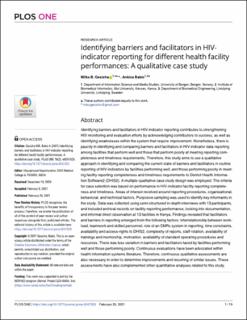Identifying barriers and facilitators in HIV-indicator reporting for different health facility performances: A qualitative case study
Journal article, Peer reviewed
Published version

Åpne
Permanent lenke
https://hdl.handle.net/11250/2766051Utgivelsesdato
2021Metadata
Vis full innførselSamlinger
Sammendrag
Identifying barriers and facilitators in HIV-indicator reporting contributes to strengthening HIV monitoring and evaluation efforts by acknowledging contributors to success, as well as identifying weaknesses within the system that require improvement. Nonetheless, there is paucity in identifying and comparing barriers and facilitators in HIV-indicator data reporting among facilities that perform well and those that perform poorly at meeting reporting completeness and timeliness requirements. Therefore, this study aims to use a qualitative approach in identifying and comparing the current state of barriers and facilitators in routine reporting of HIV-indicators by facilities performing well, and those performing poorly in meeting facility reporting completeness and timeliness requirements to District Health Information Software2 (DHIS2). A multiple qualitative case study design was employed. The criteria for case selection was based on performance in HIV-indicator facility reporting completeness and timeliness. Areas of interest revolved around reporting procedures, organizational, behavioral, and technical factors. Purposive sampling was used to identify key informants in the study. Data was collected using semi-structured in-depth interviews with 13 participants, and included archival records on facility reporting performance, looking into documentation, and informal direct observation at 13 facilities in Kenya. Findings revealed that facilitators and barriers in reporting emerged from the following factors: interrelationship between workload, teamwork and skilled personnel, role of an EMRs system in reporting, time constraints, availability and access-rights to DHIS2, complexity of reports, staff rotation, availability of trainings and mentorship, motivation, availability of standard operating procedures and resources. There was less variation in barriers and facilitators faced by facilities performing well and those performing poorly. Continuous evaluations have been advocated within health information systems literature. Therefore, continuous qualitative assessments are also necessary in order to determine improvements and recurring of similar issues. These assessments have also complemented other quantitative analyses related to this study.
